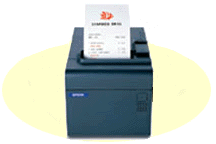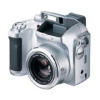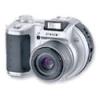I don't understand the difference between receiving orders via the Internet versus receiving orders via fax. What's the difference? There are two tasks that require the use of connectivity to the Internet. The first is maintaining the web-portal. For example, if you should choose to add an item to your beverage list, you would have to make the needed entries in the client software, and then send the changes to the portal. This always requires Internet connectivity of some type and is very simple to do. The second is receiving orders. The eat2go portal, food-PORT, has the capability to deliver orders, placed by your clients on the web, in three ways of your choosing, via: (1) Internet, (2) fax, or (3) both.
- Let's first address order delivery via the Internet. In order for this to occur you must have a permanent stable connection through your ISP (Internet Service Provider). You do not have to have a static IP address, but obviously you do not want forced disconnections every two hours. A static IP address is something assigned to you by Internic, the governing body administering the Internet, or passed on to you by your ISP. We will not address static IP addresses any further because they are not required. A permanent connection to the Internet is usually achieved by utilizing broadband connectivity. Broadband connectivity to the Internet refers to any connection method other than dial-up. So, in summary, there are two ways to get connected to the Internet, (1) through a modem and a standard telephone line, that is, dial-up, or a (2) permanent connection such as DSL, IDSL, ADSL, cable, dish, etc. When an order is placed by your clients on the web, as soon as it is finalized, the data gets sent by the portal to your computer. This data is then stored on your local computer and is printed at a printer. You can mine this data for information and produce reports. If the orders come from registered users, you get the users' profile information such as the e-mail addresses, etc. The trick to receiving such information via the Internet is a permanent stable connection which is seldomly achieved with dial-up. If you have faith in your local ISP and wish to attempt a permanent connection via dial-up, should you drop this connection, you will be notified on you computer's console and the target printer you selected for the orders to print. The inconvenience then becomes re-establishing the dropped connection.
- In case you wish to receive orders via fax, your account will be configured, during the initial setup of eat2go food-PORT, to do so. You would still maintain your portal using Internet connectivity of some type, but the orders would arrive at a fax number provided. All that is needed is a fax machine. A connection to the Internet is not required. The computer housing your information does not even have to be located on premises. Assuming menus never change, all you would do is tear the fax sheets and prepare the food. You may even have someone other than yourself or someone outside the organization maintain your portal. If you choose this method of delivery of orders to your place of business you should be aware of some considerations. A fax is not data, but a piece of paper. You cannot electronically mine fax documents. You will not be able to obtain client information and monitor purchasing habits of your clients. The upside is that you don't have to consider a monthly expense of a broadband connection. Dial-up connections range from $5.00 - $19.00 per month.
- The salvation to receiving fax documents, versus data, is that you can request your portal to be setup to do both. You would receive your orders via fax during daily operations. At the end of the workday you may temporarily obtain a connection with your portal, through your local ISP, and at that time, receive all the orders in data format.
In summary, the use of the Internet as the sole delivery transport of orders generated by the web-portal, depends upon your confidence in your ISP, availability of broadband within the merchant's organization, and volume.
How long has eat2go been around? eat2go is a multi-generational product. eat2go was first introduced in 1999. The developers of eat2go have been providing information technology solutions to the food-service industry since the early 1990's. With thousands of food-service operators as clients from Key West to Alaska and Mexico to Manila, we know the plight of the food-service operator well. We always strive to push the technology envelope and introduce new concepts and new designs to make the life of the restaurateur a little easier. With proprietary gateways and order delivery systems, server farms and fax farms, text messaging systems and redundant fallback policies, the eat2go solution is very affordable, robust and reliable.
What hardware do I need for eat2go? A PC is needed. This PC can reside at the place of business or elsewhere. A PC is required to tell the portal what to do, or if there has been a change, an addition or a deletion made. As long as nothing has changed, the portal proceeds to operate using the last instructions it was provided. Next, some type of connectivity is needed. Either a stable connection to the Internet is required, or a standard fax machine. If you choose to receive orders via the Internet through a PC, a printer of some type is also required. A fax machine already has a printer built in. Keep in mind, that although you may receive orders via a fax machine, the information that is sent to you by the portal is not really in electronic or data format. The image cannot be stored for any useful purpose and cannot be manipulated or mined. Also, you a digital camera is required, if you wish to image your product. For more information regarding a camera, click here.
What's the difference between an Internet portal and a shopping cart?
There are several distinct phases, in terms of evolutionary stages, or predecessors, pertaining to portals: static pages, carts, portals and ea2go Food-Port. Once the world wide web came into it's own, the predominant animal that ruled the web was the static page. These can be very attractive and enticing. Frequently; however, during merchant interviews, when asked what does your current web-site do for you, the answer is somewhat nebulous. So as far as the divisions of web uses is concerned, static pages were a little disappointing. As far as the evolution of the web went, merchants wanted more.
Then came e-commerce and shopping carts. These are a marriage between static pages with an addition of a sale functionality. These types of web-sites are less disappointing; these web-sites actually do something for the merchant. All one had to do is hire a web designer that laid out product of the merchant in HTML and connected product links and possibly images to a shopping cart provider's basket (If a change was requires, someone had to dive into code (HTML, Javascript, ASP) to make the adjustments). At the end of the ordering process, a credit card would be used by the customer to authorize the order and the details would be sent to the merchant via e-mail. In this paradigm, there is a clear distinction between what's presented to the customer on the web, and the merchant's brick-and-mortar operation. The link between the two, at best, is getting the order via e-mail.
And then came the portal. First, an Internet portal is a product, not a service. The service aspect of a portal is only applicable in the sense that it is hosted somewhere, just like a web-site, and it performs the service of exchanging information. This is very different from a cart. Unlike a portal, with a cart, the analogy is like having bought an automobile that requires and comes with a mechanic. And indeed, the first autos required this. A portal; however, is the next generation within the evolutionary process of the web, one that is self-sufficient and which lets the driver drive the auto by turning a key: without specific knowledge on how it works, rather than having to crank and pour fluid into the carburetor to get it started and keep it going. This animal; therefore, is also much more intelligent. Portals are much more useful systems that are much harder to design, but much more utilitarian in nature. There is an interdependence of data between a local system and the web, and the distinction between a local system and the web representation becomes much harder to discern. These are a direct reflection of the merchant's operation and what the merchant has on his system. They present a gateway, a looking glass, or a direct portal, if you will, from the world wide web, into the merchant's place of business. It's more like having a point of sale terminal which is on the web, rather than having a web-site. The benefits of having a portal are many. But if a merchant could be granted a single wish to have the ability to present to his customer, a self ordering system, and a real-time menu the he controlled, and which he did not have to reprint, his wish would be answered in terms of a portal.
What does a receipt look like?
This sample receipt was produced using a POS printer, but one is not required.

eat2go administration program prints to any printer on the network, and can go wireless to the merchant's make-line printer in the kitchen or anywhere else...
What kind of printer do I need to print Internet orders? Any kind. The use of a POS (point-of-sale) printer, is not required. If you wish you may use one and present the receipt to the customer. If you are receiving orders via fax, obviously, this answer does not apply.
What kind of computer should I get? eat2go food-PORT does not need specialized equipment. Any, on today's market will do.
If we wish to have our inventory imaged, what kind of camera should we use? A digital camera... Seriously, any camera will do. The resolution of any digital camera on the market has always been at least 640 x 480 pixels. Images used by food-PORT are sized less than that. For best results, you should attempt to shoot at around 200 x 150. For more information, consult your food-PORT user documentation. When selecting a camera, two factors are important. First, there is price considerations, and second there is feature and usefulness considerations. Do not pay attention to digital zoom specifications of any digital camera. What's important is the optical zoom specs. Some cameras do not have an optical zoom capability. This is a kin to an instamatic film camera that does not have an adjustable lens. The implications are the same as with a film camera. It does not mean that you will take pictures that are less in quality or composition. It just means that you will have to control your environment in order to get a good shot. Obviously, the most important component in any camera, all other things begin equal, is the lens. Also, it helps if you see your subject through the lens, especially if you are shooting to get a very tight frame with a consistent border. If you are going to get a digital camera and quality and usefulness is the only consideration, then we prefer the following models:
Sony F828
Street price around $1100-$1200 USD
Takes Memory Stick. Best battery life by far of ANY digital. Lot's of great pictures
7X Optical ZoomNikon D40, D50, D70
Street price around $1200-$650
CF/SD Media. True SLRs. Excellent battery life and best shutter lag.Sony F717
Street price around $650-$900 USD
Takes Memory Stick. Best battery life by far of ANY digital. Lot's of great pictures
5X Optical ZoomMinolta dImage 7i
Street price around
$650-$900 USD
Very nice.
7X Optical Zoom
Fuji 3800
Street Price around
$300-$450 USD
Nicely priced for all the features
6X Optical Zoom
Sony MVC-CD250/400
Street price around
$390-$500 USD
Work-Horse.
Saves to CD/CD-R
up to 1200 pics!!!
3X Optical Zoom
How long does it take to mount up a merchant? Without imaging, and if the merchant does not have an unusually extensive menu, and not considering administrative issues, about a day. With imaging, assuming all the product is available, on the average, it takes about 2 minutes, or less, per image, once your backdrop is setup and providing you have a decent digital camera and good lighting. The first time around, you should take a variety of test shots against different backgrounds, slightly different angles, etc, and publish to the web-portal. Pick one theme you like, and go.
What should I use to shoot images on? What color plates should be used? Use a warm neutral background. Make sure there is adequate lighting from multiple sources coming from all directions so no dominant shadows are formed. Shoot the object from a 50% degree angle into the background. You may try other angles, if you want. White plates may be used. Make sure there is contrast between the background, the product, and the plates.
Is imaging required by food-PORT? No. But it makes the ordering process more attractive and more complete. You may image some products, none of the products, or any combination thereof, and at any time after the initial mount.
How easy is it to attach pictures once they are taken? If you can figure out how to connect the camera to the PC and download the pictures from the camera, then you will think that the task of attaching the pictures to the product is a piece of cake, relatively speaking. The hardest part will be connecting the camera to the PC.
What browsers is eat2go food-PORT compatible with? eat2go food-PORT is compatible with Internet Explorer® 5 or greater and Netscape® 6 or greater. That represents almost 100% of all browsers used.
Are there any special settings that the user has to adjust on their browsers to use eat2go food-PORT? No. Not really. They should permit cookies, and they should run their screen resolution at 1024 x 768 or greater. However, 800 x 600 is fine. food-PORT will detect and adjust for the resolution.
What is browser caching? Caching is a concept a kin to learning by route in a biological organism. When we perform a task over and over again we tend to get faster at it, and we recall things without question. Once a computer performs any type of data reads, it has an option to save that data in a special area for faster retrieval if there should happen to be a next time that same data is requested. That is called a cache (pronounced cash). If a browser's cache is turned on, the browser will cache everything. Every page visited and every image that is seen by the user is saved in a designated local folder. Frequently, this data occupies a heck of a lot of storage. What that means is, if a browser visits a page next time around and detects an image of the same name, and also finds a copy of that image in its cached space, it will use its local copy instead of taking the time of downloading it, and then displaying it. The browser does the same thing with whole pages. If a local copy is present, that is what the user sees. There are implications to this type of "intelligence". If an image is changed by the web administrator, or worse yet, if a whole page has changed, you may not know about it because you may be seeing a local copy. For the most part, caching does not apply to food-PORT because the pages the user sees are generated by the server. They look like normal pages that a person would generate, but they are not. Caching rules and side-effects do apply to help screens and other static information. The page you are currently reading is subject to caching and its effects. If you are unsure if you are seeing a cached page, you may reload/refresh the page. In Internet Explorer® this is accomplished by right-clicking on the page and selecting "Refresh". You may also tune you browser's "intelligence" as far as caching is concerned. In Internet Explorer®, select "Tools", "Internet options" and "Settings". Select a setting of your choice. A good one, especially, if you have broadband, is "Every time you start Internet Explorer", providing you understand the implications of this selection.
Does eat2go support text messaging through my cell phone? Yes, but only for non-critical functions like order confirmations. Text messaging, SMS, and email is not completely reliable. eat2go is a multi-generational product that has been around since 1999. Hence we don't even use email, but a proprietary gateway which ensures order arrival. While others are still scratching their heads, crying "Eureka!", we've moved on. We discontinued support of all text messaging facilities except for non-critical ones that do not jeopardize order arrival.
What is HTML? HTML stands for (h)ypertext (m)arkup (l)anguage. It is a language that browsers read and based upon the interpretation, perform display and other activities. There are other "languages" that are used in conjunction with HTML. These are XML, Javascript, VBScript, ASP, PHP, just to name a few.
HOME
If you have a question you would like answered, please e-mail your query to: info@eat2go.net.
eat2go has no special affiliation with any of the manufacturers of digital equipment or any other equipment presented herein. The recommended herein products are suggestions rather than recommendations. We encourage you to read the Terms Of Use of eat2go websites.